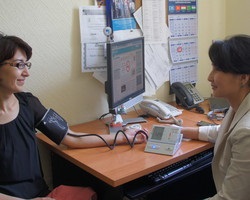New WHO report: population-based screening for cardiovascular disease risk factors does not reduce CVD mortality

WHO/Aziz Adkhamov
Population-level screening for cardiovascular disease (CVD) risk factors has no effect on lowering CVD morbidity and mortality, concludes a recently published WHO Health Evidence Network (HEN) report. To reduce CVD risks, which are also associated with poorer COVID-19 outcomes, the report proposes some alternative measures for consideration by policy-makers in the WHO European Region.
CVDs are the main cause of death globally, killing an estimated 17 million people each year. Early evidence also points to a heightened susceptibility to, and risk of poor outcomes from, COVID-19 among people with CVDs and associated risk factors such as hypertension. There is an urgent need to effectively address CVDs and reduce the health and economic burden of disease in the European Region.
Cardiovascular screening: what does the evidence say?
Screening the population for risk factors for CVD is one mechanism used by various countries in the Region to identify and address the CVD burden. However, a new WHO/Europe HEN report which synthesized several high-quality randomized controlled trials found that population-level screening for CVD risk factors has no effect on lowering CVD morbidity and mortality at a population level.
Evidence from the Region also showed that while screening for preclinical CVD had some effect on reducing mortality and negative outcomes related to abdominal aortic aneurysm (AAA), the evidence was outdated due to changed population risk factors and improvements in treatment.
According to the HEN report, results from research which is currently in progress are still needed before recommendations can be made about the implementation of screening programmes for other preclinical CVDs, including atrial fibrillation.
How to increase effectiveness of screening: WHO policy considerations
Based on the HEN synthesis findings, the key policy considerations for Member States of the Region are to:
- review systematic population-level screening programmes for CVD risk and CVD risk factors (if such already exist), avoid initiating new analogous programmes and consider alternative methods to achieve the desired outcomes in reducing the CVD burden;
- re-evaluate current systematic population-level programmes for screening for AAA, taking into account the changes in risk factors and improved treatment;
- await the results of current quality trials on the effectiveness of screening for other preclinical CVDs before considering the implementation of such programmes.
While the evidence suggests that population-level screening is not effective, it is crucial that policy-makers do not discount the potential value of case-finding – which involves assessing patients who may be at risk of CVD when they use the health-care system. While systematic screening may be a standalone programme which invites all members of the public to participate, case-finding is integrated with the health-care system and focuses on individuals as they use the system.
Reducing CVDs, remains important for the whole Region and globally. An effective CVD prevention programme incorporates multiple fiscal and policy strategies (including tobacco control, salt reduction and elimination of trans fats) as well as management of CVD risk factors, such as hypertension in primary health care, which can be effectively supported by WHO-recommended tools.
The Health Evidence Network: catalyst to WHO’s mandate to generate evidence
This HEN synthesis report is part of WHO’s initiative to increase the effectiveness of screening, maximize benefits and minimize harm, aimed at understanding the effectiveness of systematic population-level screening programmes for reducing the burden of CVD.



